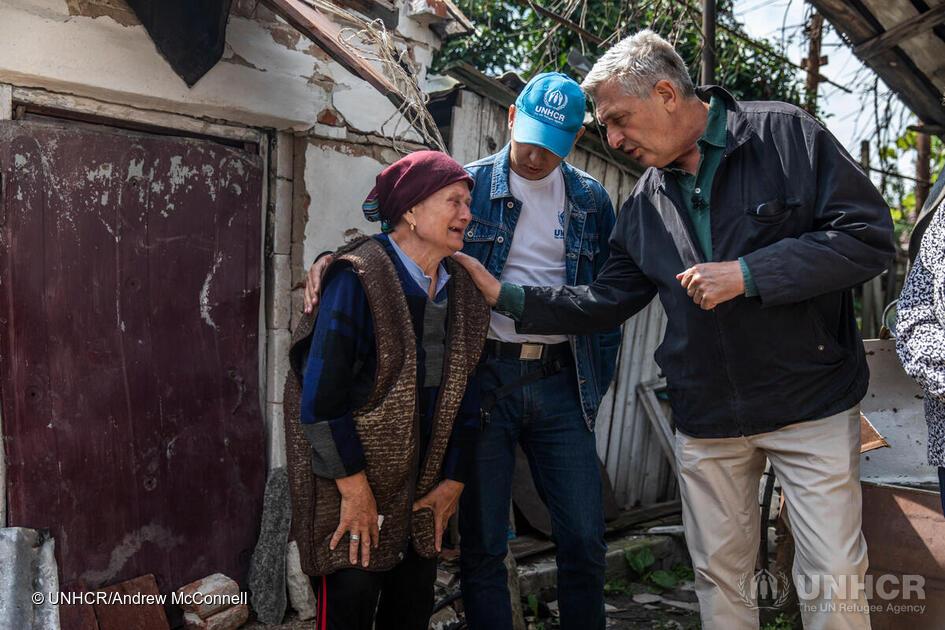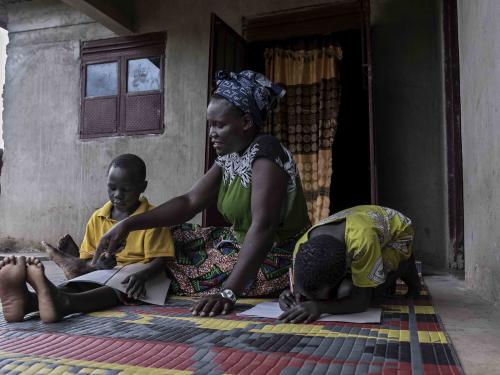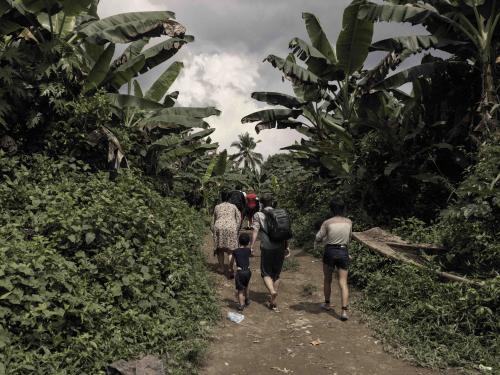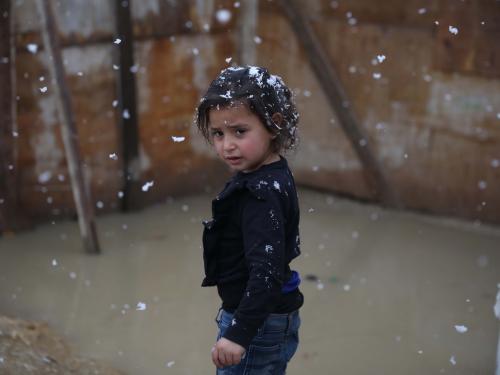Appeal
What is the Global Appeal?
The Global Appeal provides information about UNHCR’s plans for the coming year and the funding it needs to protect, assist and empower a record number of forcibly displaced and stateless people, and to help them find solutions to their situations.
UNHCR requires
$10.211 billion
to support an expected
117.2 million
displaced and stateless people
in
134
countries and territories

What you will find in the Appeal
How many people might need UNHCR’s help in 2023?
UNHCR bases its plans on population planning figures – estimates of the numbers of forcibly displaced and stateless people – that allow it to forecast the likely scale of its funding needs for the year.
Go to the planning figures ↓
What improvements does UNHCR want to see in the lives of forcibly displaced and stateless people?
The four “Impact Areas” describe the big picture: the protection of people covered by UNHCR’s mandate, the response to their needs, their empowerment, and the prospects for ending their situations of forced displacement or statelessness.
Go to the impact areas ↓
How is UNHCR aiming to make a difference?
The “Outcome Areas” explain UNHCR’s plans to bring about positive changes in 2023, and the “Enabling Areas” describe plans for making UNHCR work in a more efficient and effective way.
Go to the outcome and enabling areas ↓
What are some of UNHCR’s areas of strategic focus?
Four topics with a wide relevance to UNHCR’s work are discussed in interviews with senior UNHCR staff. These four “Focus Areas” are climate action, statelessness, UNHCR’s work with development actors, and situations of internal displacement.
Go to the focus areas ↓
How do UNHCR’s plans vary in the different regions where it works?
UNHCR’s operations are covered by seven regional bureaux. Its work in each region is summarized here, along with the budgetary needs foreseen in each region.
Go to the regional summaries ↓
Download full report
2023 Global planning figures
117.2 million people will be forcibly displaced or stateless in 2023, according to UNHCR's estimations.
A comparison of major displacement crises shows the 2022 Ukraine emergency caused an unprecedented spike in numbers.
Impact areas
UNHCR seeks positive changes in the lives of forcibly displaced and stateless people globally.
Their situation can be described under four headings, relating to how they are protected, assisted and empowered, and the eventual resolution of their situation.
These are known as the “Impact Areas” within UNHCR’s global results framework.
PROTECT
Attaining favourable protection environments
Global needs: $2.429 billion
Regional needs:
RESPOND
Realizing rights in safe environments
Global needs: $4.815 billion
Regional needs:
EMPOWER
Empowering communities and achieving gender equality
Global needs: $1,339 billion
Regional needs:
SOLVE
Securing solutions
Global needs: $1.131 billion
Regional needs:
Outcome and enabling areas
UNHCR’s plans and actions are tracked in COMPASS under 16 Outcome Areas. These describe the various ways in which UNHCR works to achieve the desired Impacts.
The five Enabling Areas cover support and management functions needed to run UNHCR’s programmes and help the organization work more efficiently and effectively.
Access to territory, registration and documentation
Global needs: $683 million
Coverage: Access to territory, reception conditions, infrastructure and management of reception/transit centres including basic assistance, identification, registration and profiling, legal identity and documentation.
Attaining favourable protection environments
Global needs: $276 million
Coverage: Administrative institutions support, promotion of international and regional instruments, strategic litigation, law and policy enhancement, public attitudes.
Refugee status determination
Global needs: $200 million
Coverage: Status determination interventions, information provision, assistance programmes to government processes, asylum system strengthening, handover of procedures.
Gender-based violence
Global needs: $340 million
Coverage: GBV prevention, risk mitigation and response. protection against sexual exploitation and abuse.
Child protection
Global needs: $252 million
Coverage: Community-based child protection structures, best interest determination, prevention and response services for adolescents and children, children associated with armed groups.
Safety and access to justice
Global needs: $312 million
Coverage: Coverage: Specific needs/ service provision, legal assistance to individuals and families, freedom of movement, alternatives to detention, security/crime related interventions, trafficking and smuggling.
Community engagement and women's empowerment
Global needs: $569 million
Coverage: Community sensitization, peace education, peaceful coexistence projects, community-based complaint mechanisms, community self-management structures, gender equality interventions, women’s empowerment.
Well-being and basic needs
Global needs: $2.342 billion
Coverage: Multipurpose cash, food security and food assistance, in-kind and core relief items including cooking fuels.
Sustainable housing and settlements
Global needs: $906 million
Coverage: Housing, emergency shelter, transitional and permanent housing, settlement and urban planning, energy, environmental and natural resource management.
Healthy lives
Global needs: $559 million
Coverage: Primary health care, secondary health care, preventative health programmes, reproductive health and HIV, mental health, nutrition, other health-related interventions including advocacy and support for inclusion of persons of concern in national services
Education
Global needs: $466 million
Coverage: Primary education, secondary education, additional/higher/tertiary education, vocational training, inclusion into national education system.
Clean water, sanitation and hygiene
Global needs: $236 million
Coverage: Coverage: Water systems, sanitation including toilets, bathing areas, hygiene promotion.
Self-reliance, economic inclusion and livelihoods
Global needs: $591 million
Coverage: Self-employment (business), wage employment, agriculture, fishing, economic opportunities promotion, job creation, entrepreneurship programmes, resilience programmes.
Voluntary repatriation and sustainable reintegration
Global needs: $251 million
Coverage: Voluntary return preparations, organisation/ assistance of voluntary return, work in country/ area of origin to create conditions for return and sustained reintegration.
Resettlement and complementary pathways
Global needs: $182 million
Coverage: Resettlement preparation and management, emergency resettlement relocation, private or community sponsorship programmes, humanitarian visas, humanitarian corridors, family reunification, student visas, other complementary pathways.
Local integration and other local solutions
Global needs: $441 million
Coverage: Coverage: Naturalisation, durable legal status, permanent residency.
Systems and processes
Global needs: $197 million
Coverage: Systems renewal, partner management, budgeting and financial management systems, results and resource information management systems, operational data management systems, planning and implementation management systems, digital transformation, data governance.
Operational support and supply chain
Global needs: $330 million
Coverage: IT support, travel, finance, vehicle fleet management, warehousing, supply chain processes and procedures, procurement, supply workforce development, transport, inventory management, greening the blue, emergency preparedness and response capacity, security management architecture
People and culture
Global needs: $137 million
Coverage: Human resources management, learning and development, organizational legal and technical counsel, policy oversight and coordination, risk management and ethics.
External engagement and resource mobilization
Global needs: $423 million
Coverage: Communication and advocacy, public and private sector fundraising and strategic partnership management, including through operational partnerships and inter-agency coordination.
Leadership and governance
Global needs: $21 million
Coverage: Executive direction, governance liaison and coordination, evaluation, audit, Inspector General’s Office.
Focus areas
Some aspects of UNHCR’s strategy deserve a particular focus but have implications that cut across many different areas of work.
UNHCR has four focus areas.
INTERNAL DISPLACEMENT
If funding is not forthcoming, especially both on the humanitarian and the solutions development side, it will be a tragic loss of opportunity.
- Sumbul Rizvi, UNHCR Principal Adviser on Internal Displacement
STATELESSNESS
We always stress to governments that statelessness is a solvable problem, and we have many good practices to draw on. What is most important is political will.
- Monika Sandvik, UNHCR Senior Statelessness Coordinator
CLIMATE ACTION
People who are displaced often don’t have the resources to adapt or prepare, and they are often displaced to the margins of society, to areas that are going to be hit the hardest.
- Andrew Harper, UNHCR Special Adviser on Climate Action
WORKING WITH DEVELOPMENT PARTNERS
There is greater understanding now that forced displacement is not just a humanitarian challenge, and that development can play a significant role in responding to this challenge.
- Sajjad Malik, Director of UNHCR’s Division of Resilience and Solutions
Regional summaries
UNHCR’s operations are covered by seven regional bureaux.






